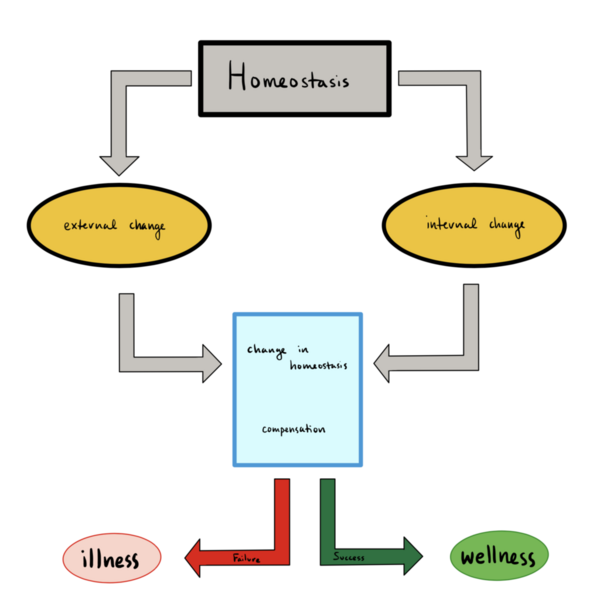Homeostasis
Original Editor - [[User:Lucinda hampton|Lucinda hampton
Top Contributors - Lucinda hampton
Introduction[edit | edit source]
Homeostasis, as defined thus "A self-regulating process by which biological systems maintain stability while adjusting to changing external conditions"[1]. Our bodies various functions must operate in a narrow range of balance internally, a dynamic equilibrium, in spite of a changing external environment. Our individual cells require our body to maintain these conditions to prevent the death of our cells, tissues and organs. [2]The body achieves this dynamic homeostasis by regulating temperature, glucose, toxins, blood pressure and pH.
Homeostasis is largely controlled by central nervous system and the endocrine system (hormones). The organs in the these systems send orders various organs in all systems allowing them to carry out vital functions, working within a looped system. These two systems form a network of nerves, glands and organs located throughout the body, that have a vital role in controlling and regulating many of the body’s functions.[3]
Measures of homeostasis[edit | edit source]
Include:
- Our vital signs (blood pressure, core body temperature, heart rate, respiratory rate, and oxygen saturation) give an indication of a possible homeostatic imbalance.
- A basic metabolic panel can be done to show electrolyte disturbances.
When Homeostasis Fails[edit | edit source]
Homeostasis failure leads to many common disease processes. For example
- Diabetes
- Hypertension
- Fever
- With the normal aging process the body's ability to keep a steady homeostatis reduces, making older people more vunerable to disease. eg older people often find it harder to regulating their body temperature, they also have a harder time fighting infections and cancer.[4]
Exercise and Homeostasis[edit | edit source]
Exercise is a powerful modulator of metabolism and it is a large protective device protective agent staving of metabolic disease, due to exercises ability to boost metabolic function in multiple organs. For example exercise is a great regulator of insulin sensitivity and cardiovascular health.[5]
- bulleted list
- x
or
- numbered list
- x
References[edit | edit source]
- ↑ Billman GE. Homeostasis: the underappreciated and far too often ignored central organizing principle of physiology. Frontiers in physiology. 2020:200.Available:https://www.ncbi.nlm.nih.gov/pmc/articles/PMC7076167/ (accessed 1.4.2023)
- ↑ Libretti S, Puckett Y. Physiology, homeostasis.Available: https://www.ncbi.nlm.nih.gov/books/NBK559138/(accessed 1.4.2023)
- ↑ Khan Academy Homeostasis Available:https://www.khanacademy.org/science/ap-biology/cell-communication-and-cell-cycle/feedback/a/homeostasis (accessed 1.4.2023)
- ↑ Libre texts Human biology Available:https://bio.libretexts.org/Bookshelves/Human_Biology/Human_Biology_(Wakim_and_Grewal)/21%3A_Disease/21.2%3A_Homeostasis_and_Disease (accessed 1.4.2023)
- ↑ Thyfault JP, Bergouignan A. Exercise and metabolic health: beyond skeletal muscle. Diabetologia. 2020 Aug;63:1464-74.Available: https://link.springer.com/article/10.1007/s00125-020-05177-6(accessed 1.4.2023)







